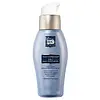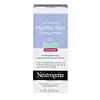What's inside
What's inside
 Key Ingredients
Key Ingredients

 Benefits
Benefits

 Concerns
Concerns

 Ingredients Side-by-side
Ingredients Side-by-side

Butyl Methoxydibenzoylmethane 2%
UV AbsorberHomosalate 4%
Skin ConditioningEthylhexyl Salicylate 4%
UV AbsorberOctocrylene 2%
UV AbsorberWater
Skin ConditioningPropylene Glycol
HumectantGlycerin
HumectantIsononyl Isononanoate
EmollientDimethicone
EmollientSteareth-2
EmulsifyingAscorbyl Glucoside
AntioxidantEthylhexyl Palmitate
EmollientStyrene/Acrylates Copolymer
Butyrospermum Parkii Butter
Skin ConditioningMethyl Methacrylate Crosspolymer
Hexylresorcinol
AntimicrobialSteareth-21
CleansingBehenyl Alcohol
EmollientDimethicone Crosspolymer
Emulsion StabilisingPhenoxyethanol
PreservativeAmmonium Acryloyldimethyltaurate/Vp Copolymer
Sodium Hydroxide
BufferingCaprylyl Glycol
EmollientSclerotium Gum
Emulsion StabilisingParfum
MaskingMica
Cosmetic ColorantTitanium Dioxide
Cosmetic ColorantMethylparaben
PreservativeDisodium EDTA
Ethylparaben
PreservativePropylparaben
PreservativeButyl Methoxydibenzoylmethane 2%, Homosalate 4%, Ethylhexyl Salicylate 4%, Octocrylene 2%, Water, Propylene Glycol, Glycerin, Isononyl Isononanoate, Dimethicone, Steareth-2, Ascorbyl Glucoside, Ethylhexyl Palmitate, Styrene/Acrylates Copolymer, Butyrospermum Parkii Butter, Methyl Methacrylate Crosspolymer, Hexylresorcinol, Steareth-21, Behenyl Alcohol, Dimethicone Crosspolymer, Phenoxyethanol, Ammonium Acryloyldimethyltaurate/Vp Copolymer, Sodium Hydroxide, Caprylyl Glycol, Sclerotium Gum, Parfum, Mica, Titanium Dioxide, Methylparaben, Disodium EDTA, Ethylparaben, Propylparaben
Butyl Methoxydibenzoylmethane 1.5%
UV AbsorberEthylhexyl Salicylate 5%
UV AbsorberOctocrylene 3%
UV AbsorberBenzophenone-3 4%
UV AbsorberWater
Skin ConditioningGlycolic Acid
BufferingC12-15 Alkyl Benzoate
AntimicrobialDicaprylyl Maleate
EmollientCetyl Alcohol
EmollientGlycerin
HumectantStearic Acid
CleansingGlyceryl Stearate
EmollientPEG-100 Stearate
Sodium Hydroxide
BufferingPhenoxyethanol
PreservativeSclerotium Gum
Emulsion StabilisingTocopheryl Acetate
AntioxidantCaprylyl Glycol
EmollientParfum
MaskingXanthan Gum
EmulsifyingMethylparaben
PreservativePanthenol
Skin ConditioningBisabolol
MaskingPropylparaben
PreservativeTetrasodium EDTA
Ascorbic Acid/Orange/Citrus Limon/Citrus Aurantifolia Polypeptides
Skin ConditioningButyl Methoxydibenzoylmethane 1.5%, Ethylhexyl Salicylate 5%, Octocrylene 3%, Benzophenone-3 4%, Water, Glycolic Acid, C12-15 Alkyl Benzoate, Dicaprylyl Maleate, Cetyl Alcohol, Glycerin, Stearic Acid, Glyceryl Stearate, PEG-100 Stearate, Sodium Hydroxide, Phenoxyethanol, Sclerotium Gum, Tocopheryl Acetate, Caprylyl Glycol, Parfum, Xanthan Gum, Methylparaben, Panthenol, Bisabolol, Propylparaben, Tetrasodium EDTA, Ascorbic Acid/Orange/Citrus Limon/Citrus Aurantifolia Polypeptides
Ingredients Explained
These ingredients are found in both products.
Ingredients higher up in an ingredient list are typically present in a larger amount.
Also known as Avobenzone, this ingredient is a chemical sunscreen filter that provides protection in the UV-A range.
Avobenzone is globally approved and is the most commonly used UV-A filter in the world.
Studies have found that avobenzone becomes ineffective when exposed to UV light (it is not photostable; meaning that it breaks down in sunlight). Because of this, formulations that include avobenzone will usually contain stabilizers such as octocrylene.
However, some modern formulations (looking at you, EU!) are able to stabilize avobenzone by coating the molecules.
Avobenzone does not protect against the UV-B range, so it's important to check that the sunscreen you're using contains other UV filters that do!
The highest concentration of avobenzone permitted is 3% in the US, and 5% in the EU.
Learn more about Butyl MethoxydibenzoylmethaneCaprylyl Glycol is a humectant and emollient, meaning it attracts and preserves moisture.
It is a common ingredient in many products, especially those designed to hydrate skin. The primary benefits are retaining moisture, skin softening, and promoting a healthy skin barrier.
Though Caprylyl Glycol is an alcohol derived from fatty acids, it is not the kind that can dry out skin.
This ingredient is also used as a preservative to extend the life of products. It has slight antimicrobial properties.
Learn more about Caprylyl GlycolEthylhexyl Salicylate is an organic compound used to block UV rays. It primarily absorbs UVB rays but offers a small amount of UVA protection as well.
Commonly found in sunscreens, Ethylhexyl Salicylate is created from salicylic acid and 2-ethylhexanol. You might know salicylic acid as the effective acne fighter ingredient and BHA.
The ethylhexanol in this ingredient is a fatty alcohol and helps hydrate your skin, similar to oils. It is an emollient, which means it traps moisture into the skin.
According to manufacturers, Ethylhexyl Salicylate absorbs UV wavelength of 295-315 nm, with a peak absorption at 307-310 nm. UVA rays are linked to long term skin damage, such as hyperpigmentation. UVB rays emit more energy and are capable of damaging our DNA. UVB rays cause sunburn.
Learn more about Ethylhexyl SalicylateGlycerin is already naturally found in your skin. It helps moisturize and protect your skin.
A study from 2016 found glycerin to be more effective as a humectant than AHAs and hyaluronic acid.
As a humectant, it helps the skin stay hydrated by pulling moisture to your skin. The low molecular weight of glycerin allows it to pull moisture into the deeper layers of your skin.
Hydrated skin improves your skin barrier; Your skin barrier helps protect against irritants and bacteria.
Glycerin has also been found to have antimicrobial and antiviral properties. Due to these properties, glycerin is often used in wound and burn treatments.
In cosmetics, glycerin is usually derived from plants such as soybean or palm. However, it can also be sourced from animals, such as tallow or animal fat.
This ingredient is organic, colorless, odorless, and non-toxic.
Glycerin is the name for this ingredient in American English. British English uses Glycerol/Glycerine.
Learn more about GlycerinMethylparaben is a preservative and is a paraben. It is used to prevent the growth of fungus, mold, and other harmful bacteria. Parabens are chemicals used as preservatives in both cosmetics and food.
Methylparaben can be synthetically created. It can also be found naturally in some fruits, such as blueberries.
Oftentimes, Methylparaben is combined with other parabens to help increase the shelf life.
The safety of Methylparaben is currently being studied. While ongoing studies are looking into the safety of parabens, the results have been very mixed. Some studies have not found Methylparaben to be harmful.
Learn more about MethylparabenOctocrylene protects skin from sun damage. It absorbs UV-B with peak absorption of 304 nm. It is a common sunscreen ingredient and often paired with avobenzone, a UVA filter. This is because octocrylene stabilizes other sunscreen ingredients by protecting them from degradation when exposed to sunlight. Octocrylene is a photostable ingredient and loses about 10% of SPF in 95 minutes.
Octocrylene also acts as an emollient, meaning it helps skin retain moisture and softens skin. It is oil-soluble and hydrophobic, enhancing water-resistant properties in a product.
Those who are using ketoprofen, a topical anti-inflammatory drug, may experience an allergic reaction when using octocrylene. It is best to speak with a healthcare professional about using sunscreens with octocrylene.
The EU allows a maximum of these concentrations:
Learn more about OctocryleneParfum is a catch-all term for an ingredient or more that is used to give a scent to products.
Also called "fragrance", this ingredient can be a blend of hundreds of chemicals or plant oils. This means every product with "fragrance" or "parfum" in the ingredients list is a different mixture.
For instance, Habanolide is a proprietary trade name for a specific aroma chemical. When used as a fragrance ingredient in cosmetics, most aroma chemicals fall under the broad labeling category of “FRAGRANCE” or “PARFUM” according to EU and US regulations.
The term 'parfum' or 'fragrance' is not regulated in many countries. In many cases, it is up to the brand to define this term.
For instance, many brands choose to label themselves as "fragrance-free" because they are not using synthetic fragrances. However, their products may still contain ingredients such as essential oils that are considered a fragrance by INCI standards.
One example is Calendula flower extract. Calendula is an essential oil that still imparts a scent or 'fragrance'.
Depending on the blend, the ingredients in the mixture can cause allergies and sensitivities on the skin. Some ingredients that are known EU allergens include linalool and citronellol.
Parfum can also be used to mask or cover an unpleasant scent.
The bottom line is: not all fragrances/parfum/ingredients are created equally. If you are worried about fragrances, we recommend taking a closer look at an ingredient. And of course, we always recommend speaking with a professional.
Learn more about ParfumPhenoxyethanol is a preservative that has germicide, antimicrobial, and aromatic properties. Studies show that phenoxyethanol can prevent microbial growth. By itself, it has a scent that is similar to that of a rose.
It's often used in formulations along with Caprylyl Glycol to preserve the shelf life of products.
Propylparaben is a preservative and is a paraben with antifungal and antimicrobial properties.
This ingredient can be naturally found in plants and insects, but most of it is synthetically manufactured for human use. In cosmetics, it is usually created by reacting para-aminobenzoic acid and propanol (an alcohol).
You can usually find this ingredient in water-based products.
Parabens have come under controversy due to the claim they are hormone disruptors. Studies show conflicting results. We recommend speaking with a professional if you have any concerns.
Propylparaben is commonly found in food, medicine, and cosmetics.
Learn more about PropylparabenSclerotium Gum is a polysaccharide gum made by the fungus, Sclerotium rolfssii. It is similar to xanthan gum.
In cosmetics, Sclerotium Gum is used to thicken the texture and to help stabilize other ingredients.
As an emulsifier, Sclerotium Gum helps prevent ingredients from separating, such as water and oil.
Learn more about Sclerotium GumSodium Hydroxide is also known as lye or caustic soda. It is used to adjust the pH of products; many ingredients require a specific pH to be effective.
In small amounts, sodium hydroxide is considered safe to use. However, large amounts may cause chemical burns due to its high alkaline.
Your skin has a natural pH and acid mantle. This acid mantle helps prevent harmful bacteria from breaking through. The acid mantle also helps keep your skin hydrated.
"Alkaline" refers to a high pH level. A low pH level would be considered acidic.
Learn more about Sodium HydroxideWater. It's the most common cosmetic ingredient of all. You'll usually see it at the top of ingredient lists, meaning that it makes up the largest part of the product.
So why is it so popular? Water most often acts as a solvent - this means that it helps dissolve other ingredients into the formulation.
You'll also recognize water as that liquid we all need to stay alive. If you see this, drink a glass of water. Stay hydrated!
Learn more about Water